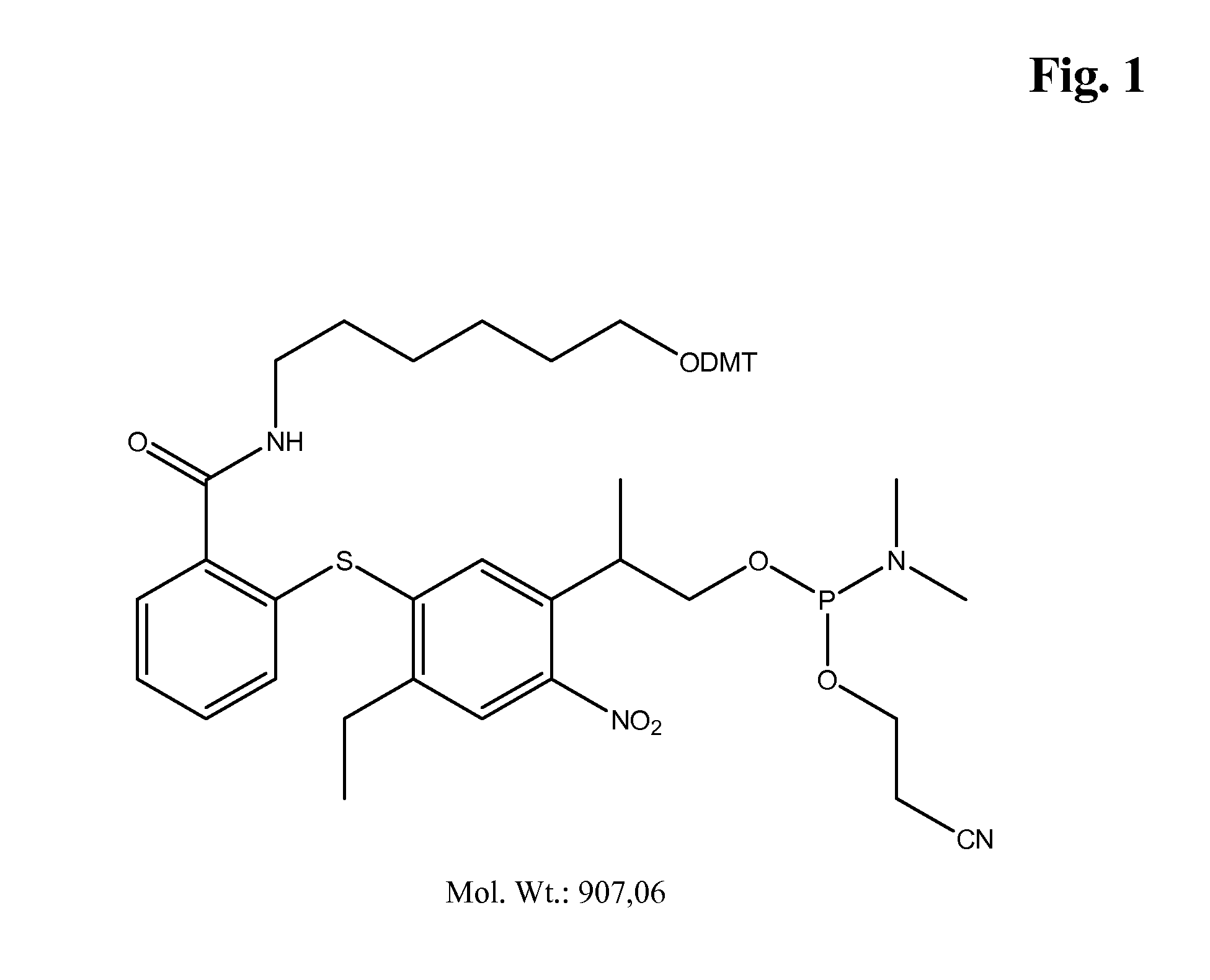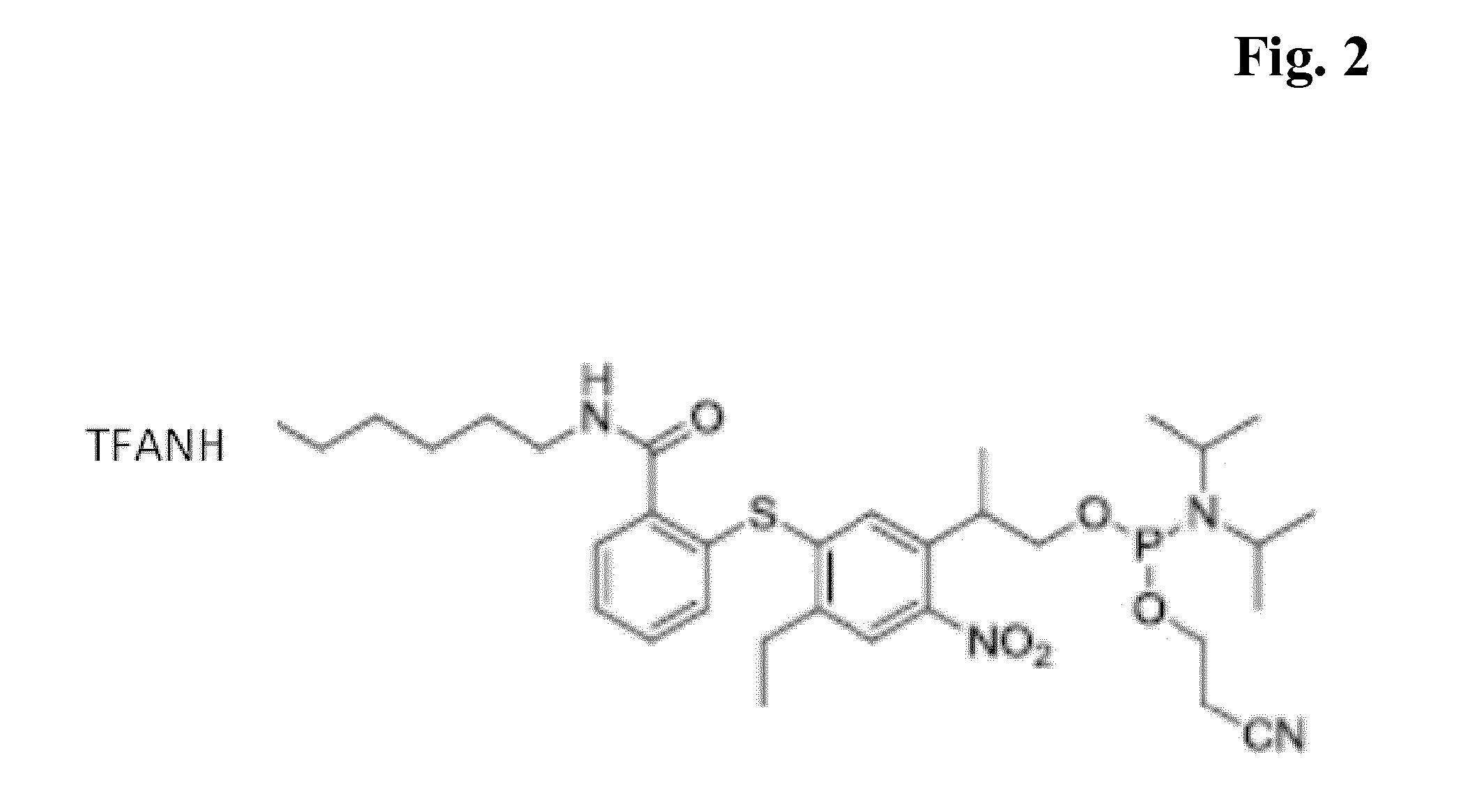Photocleavable linker molecules with diarylsulphid backbone for transient bioconjugate synthesis
a bioconjugate and linker molecule technology, applied in the field of photocleavable compounds, can solve the problems of high overall cost of operation, high purchase cost, and increased cos
- Summary
- Abstract
- Description
- Claims
- Application Information
AI Technical Summary
Benefits of technology
Problems solved by technology
Method used
Image
Examples
example 1
Synthesis of a Photocleavable Spacer Amidite as a Building Block for Oligonucleotide Synthesis
[0050]231 g of 2,5-diethyl-4-nitrobenzene (0.895 mol), 106.2 g thiosalicylic acid (0.688 mol) and 285 g potassium carbonate (2.064 mol) are heated to reflux in 1.2 L dimethylformaide (DMF) for 1 h. DMF is then distilled in vacuo, the residue diluted with water to a total volume of 3.5 L and extracted 6 times with 0.5 L with hexaneethyl acetate 1:1. The aqueous residue is adjusted to pH 6.0 with dilute HCl and extracted twice with 0.5 L ethyl acetate, which are combined and washed with 1 L water. Ethyl acetate is removed by a Rotavap, the residue is dissolved in dichlormethane and purified by column chromatography on silica dichloromethane.
Yield: 173.1 g (76%) Amorphous Reddish Foam after Evaporation (P3-Acid).
[0051]173 g of P3-acid (0.522 mol), 59 g paraformaldehyde (0.652 mol) and 437 g triton B (40% in MeOH=1.044 mol) are heated to 90° C. in 1.4 L DMSO for 2 h. After cooling, 0.2 L acetic...
example 2
Synthesis of the Compound of FIG. 2
Photocleavable Amino-Modifier-Amidite
[0070]In a similar manner, the photocleavable amino-modifier was prepared from P3-acid-(tBdMS-ether) and N-triflouroacetyl-1,6-diaminohexane to yield the title compound in 12% overall yield (4 steps).
example 3
Synthesis of the Compound of FIG. 3
Photocleavable Biotin-Modifier-Amidite
[0071]In a similar manner, the photocleavable biotin-modifier was prepared from P3-acid-(tBdMS-ether) and N-dimethoxytrityl-biotin-6-aminocaproylamide to yield the title compound in 9% overall yield (4 steps).
PUM
| Property | Measurement | Unit |
|---|---|---|
| wavelength | aaaaa | aaaaa |
| wavelengths | aaaaa | aaaaa |
| total volume | aaaaa | aaaaa |
Abstract
Description
Claims
Application Information
 Login to View More
Login to View More - R&D
- Intellectual Property
- Life Sciences
- Materials
- Tech Scout
- Unparalleled Data Quality
- Higher Quality Content
- 60% Fewer Hallucinations
Browse by: Latest US Patents, China's latest patents, Technical Efficacy Thesaurus, Application Domain, Technology Topic, Popular Technical Reports.
© 2025 PatSnap. All rights reserved.Legal|Privacy policy|Modern Slavery Act Transparency Statement|Sitemap|About US| Contact US: help@patsnap.com



